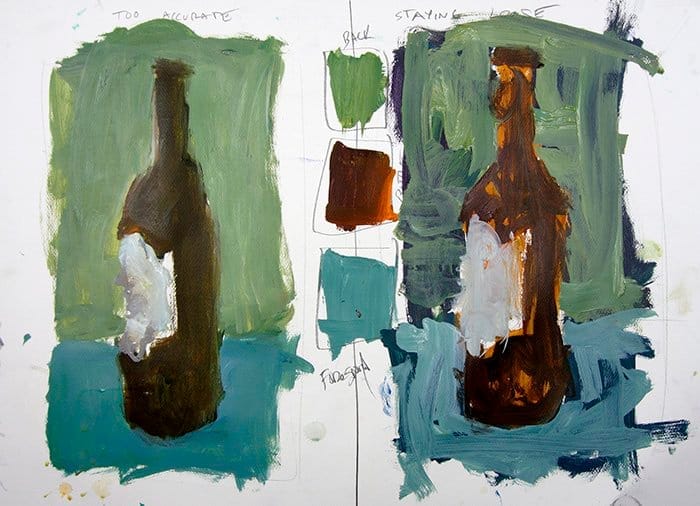How to Develop Loose Expressive Brushwork
Loose brushwork isn’t about being sloppy — it’s about expression. Learn how to avoid tightening up too soon and develop confident, expressive strokes.

When I first started painting, I often painted myself into a corner. I’d nail the background color too early, match every detail too closely, and end up with brushwork that felt stiff.
Sound familiar?
Loose brushwork isn’t about being sloppy — it’s about leaving room to play. In this lesson, we’ll look at how to avoid tightening up too soon and how to build energy and expression into your brushstrokes.
Looking for more acrylic tips, free courses, and tutorials?
Check out the Acrylic Hub — your one-stop guide for everything from beginner basics to advanced techniques.
Watch video: Hit play to discover how color and brushwork can make your painting feel looser and more expressive.
Why Brushwork Matters in Loose Painting
Brushwork is more than just a way to apply paint. It’s a tool for expression:
- Loose strokes suggest movement and life.
- Layered strokes create depth and texture.
- Confident strokes reveal the artist’s hand, not just the subject.
When you paint too accurately from the beginning, you remove your ability to use brushwork as part of the art. That’s when things get stiff.

Step 1 — Don’t Lock in Too Early
Many beginners want to “get it right” immediately. They nail the color of the background or the bottle on the first pass. But when you go too tight too soon:
- Later layers have nowhere to go.
- Brushwork feels forced.
- The painting lacks spontaneity.
Instead: keep your first layers simple, broad, and a little rough. Think of them as scaffolding, not the final wall.
Step 2 — Leave Wiggle Room for Brushwork
By holding back on perfection in the early layers, you give yourself space to show off your brushwork later.
- Let some of the underpainting peek through.
- Use transparent or slightly off colors to keep things open.
- Allow yourself to be imprecise — the magic comes later.
This wiggle room is where brushwork shines. A visible underlayer makes every new stroke more dynamic.
Step 3 — Layer with Energy and Expression
When the surface isn’t locked down, you can:
- Lay bold strokes that stand out against what’s beneath.
- Add variety in direction, pressure, and speed.
- Use the brush itself (square, round, fan) as a creative tool.
The result? A painting that looks alive, not labored.
Step 4 — Practice the Art of Loose Brushwork
Loose, expressive brushwork is a skill that develops over time:
- Awareness: Notice when you’re tightening up too early.
- Experimentation: Push yourself to leave things less finished in the first layers.
- Confidence: Trust that imperfect strokes often read better than “perfect” ones.
The more you practice, the more brushwork becomes your signature style, not just an afterthought.
The Lesson: Use Brushwork as a Tool
Loose painting unfolds when you stop trying to control every detail and start letting brushwork carry part of the story.
Your brush can do more than fill in shapes — it can create rhythm, movement, and personality. Once you see it that way, expressive brushwork becomes one of the most powerful tools in your painting.
👉 Now it’s your turn: Try holding back on your first layers, then let your brushwork do the heavy lifting. Notice how much more expressive your painting feels.
Learn & Improve Your Acrylic Skills
- Acrylic Hub– Your go-to guide for tutorials, tips, and resources.
- Subscribe for More Great Content - Get tutorials, tips, and updates straight to your inbox.
- Follow Me on Pinterest - Daily inspiration, tips, and fresh ideas.
Recommended Acrylic Painting Materials
-
Princeton Catalyst Brushes – Flats (#6, #12), Rounds (#4, #8), Fan (#4), Liner Brush
Durable synthetic bristles for versatile acrylic techniques -
Liquitex Heavy Body Acrylic Paint – Essential Colors
Cadmium Yellow, Yellow Ochre, Alizarin Crimson, Cadmium Red Light, Ultramarine Blue, Cobalt Blue, Burnt Sienna, Titanium White -
Winsor & Newton Cotton Canvas
Reliable stretched canvas for studio and plein air work -
Strathmore 400 Series Mixed Media Paper
Heavyweight, acid-free paper for acrylic and mixed media -
Fabriano Artistico 140lb Cold Press Paper
Excellent for acrylic, mixed media, and textured effects -
Blick Multi-Colored Painting Knife Set
Variety of shapes for texture, scraping, and bold strokes - Miscellaneous: Two pint-sized water containers, paper towels (from Home Depot or Walmart)
- Note: I use canvas or sturdy cardboard as my palette — no store-bought palettes needed.




